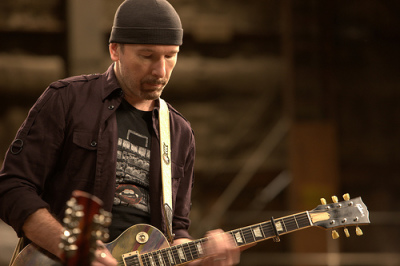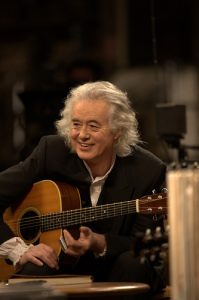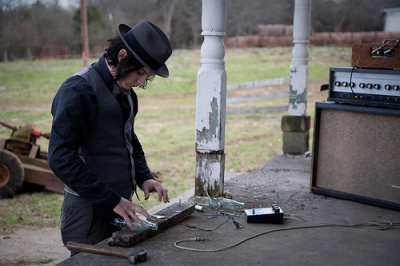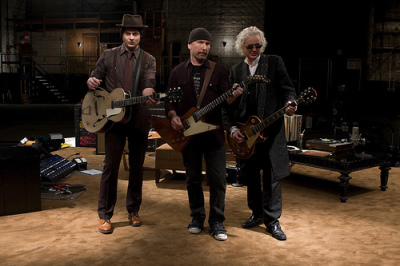By: debbie lynn elias

Things will definitely get a little bit loud with the rockumentary IT MIGHT GET LOUD, a sit down with three generations of rock legends, guitarists Jimmy Page (Led Zeppelin), The Edge (U2) and Jack White (White Stripes). Three very different gentlemen. Three very different backgrounds. Three very different styles. One common passion. This is one room in rock ‘n roll heaven.
Director Davis Guggenheim could have done no better than his subject selection so Page, White and The Edge. Each represents a significant era in music history. For Page, he has been around since the advent of rock-n-roll and, thank heaven, heavy metal. White, celebrates the bluesey-ness of the depression era but moves forward and vacillates into the angry punk era or the 80’s without compromising his musical skills, knowledge or talent. The Edge is the epitome of melding talent and technology.
With IT MIGHT GET LOUD, Guggenheim, who, together with Al Gore, brought us a little project Oscar winning film called “An Inconvenient Truth”, now brings us the stuff that dreams are made of. Giving us an up close and personal look at each of these virtuosos, we are privy to the intimate details of their childhoods (did you know Jack White was an upholsterer or that Page was a studio musician and a painter and wanted to be a biologist of some sort?) and chronicle their careers from child to adult to legend. But what is most interesting is that each gives the sense of looking at himself as a supporting character to the film’s true star – the guitar.
Fascinating is a look at the technical achievements and developments each has brought not only to music but to the guitar. For Page, it’s the double neck guitar which was initially designed and developed for the first tour following the release of Zeppelin IV with the classic, “Stairway to Heaven.” Page also is credited with incorporating mathematics into music performance with “distance equals depth”, a formula and technique still used today whereby microphones are set up right next to amps but then another mic is placed 20-25 feet away and the sound the mixed to achieve the perfect naturally resonant echo. Page is also one of the first extremely hands-on musician-producers, now often a common practice. The Edge, one of the most techno savvy guys out there, proudly displays and demonstrates his pedal sound effects designs. White is the father of invention. Give him a few nails, a piece of wood, an empty Coca Cola bottle and a steel string and he will give you an amplified guitar. White is also credited with the innovative design of a hand mic custom placed inside his guitar.
Watching the three together, the camera captures their shared passion, love and appreciation. You see what drives them, moves them, inspires them now and inspired them then. Page has an elegance and grace about him. The elder statesman, if you will. You note his long slender fingers as he not only solos, but jams with The Edge and White, and even when doing an air guitar solo to an old 45 record of his favorite, Link Wray’s “Rumble.” Page doing air guitar is beyond Grammy gold as the platinum-haired Page disappears into his youth. His face transforms into youthful joy as he lives each and every note and memory of this song. A truly beautiful moment to behold. The Edge is your average guy in the street but goes inside of himself when he starts to play. You see the emotional transformation as he becomes one with the guitar. White has an intensity and earthiness all his own which we see not only through footage of fingers and guitar strings bloodied from his furious play, but from the bluesey vibe he puts forth. Each is oblivious to the everyone and everything around them when they play. Each has a relationship with the guitar that rivals all others.
Always a huge fan of Page and Zeppelin (for me, nothing in their repertoire tops “Black Dog”), I was less familiar with White and The Edge. And while the film gives me a true appreciation for The Edge, White is the one that totally takes me by surprise and by seeing him in this quite intimate setting, has won me over as a fan for life. White, quite honestly, is a genius. His musical diversity is boundless. His musical styles eclectic. But no matter whether he is playing or writing punk, blues or rock, there is always a simplistic element of elegance that permeates his music and his performance. Of the three, it is White who, I believe, becomes his music, a fact which is so apparent as, oblivious to his own intensity, finishes a set only to find his guitar strings covered in blood and his fingers and knuckles bleeding from the fury of his fingers.
Guggenheim breaks the film into multiple thematic segments, giving the audience one-on-one time with each icon and their reminiscences, as well as taking us on little travelogues through time as each musician takes us on their individual journey “back to where it all began.” Travelling from Headley Grange where “Stairway to Heaven” and “Black Dog” were written and Page’s private tour and personal insight and recollections into his experiences there, to The Edge’s small studio in Dublin where he is laying down tracks and to his high school where he hooked up with a guy now known as Bono oh so many years ago, to an old farmhouse in Tennessee where White actually pens a tune while on camera, your hairs will stand on end with awe and excitement at watching history unfold before you. Adding to the experience is the knowledge that never before have these stories been told in this fashion. Never before has a camera been welcomed into the home of Jimmy Page or the kitchen of The Edge. We even get to see Jack White’s first electric guitar; plastic, purchased in the long-defunct Montgomery Ward’s Department Store. I had goosebumps throughout most of this film. It’s that special. And Zeppelin fans, a do not miss for you, Page’s tour of the actual staircase and hallway at Headley Grange where John Bonham recorded the echoing drum parts of the infamous “When the Levee Breaks” complete with Page commentary on the writing and recording of the album.

Interestingly, Guggenheim avoids the effusive praise and patting-on-the-back scenes so often found in films, documentaries and biographies of this nature. No fan boys or mutual admiration society going on here. In fact, never do you hear any of the three talk about being influenced by the other or even that they like what the other does. Besides the guitar, however, what they all celebrate are the musicians that came before them. However, one of the most ethereal moments in the film finds Page tearing up “Whole Lotta Love” with the Edge jumping to his feet, beaming from ear to ear watching Page’s fingers while White taps his foot to the beat leaning ever closer to a grandmaster, himself also mesmerized by the fluidity of Page’s fingers.
From the opening sequence, we are treated to what is almost a pornographic celebration of the guitar. Sharp, vivid images of smooth, silken curves of various guitars likening them to the curves of a woman. Razor-sharp steely iced guitar strings ready to rake marks across your body. As Page puts it, when handling a guitar, “caress it like a woman.” Guggenheim’s camera does just that. Crisply edited with an enormous amount of vintage footage of classic performances not only from Page, The Edge and White but their idols, interwoven with the film’s culmination of “the summit” – a first time meeting of our heroes and their jam session – this is THE film for anyone that appreciates music. And if you are a fan of any of the three, this is beyond must see.

IT MIGHT GET LOUD… oh yeah. It’s gonna get real loud. This is the penultimate intimate rock experience and your own little piece of rock ‘n roll heaven.
Jimmy Page
Jack White
The Edge
Directed by David Guggenheim. 97 minutes












